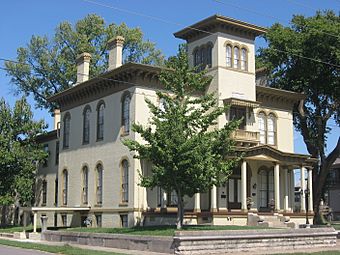Mansion Row Historic District facts for kids
The Mansion Row Historic District is a special area in New Albany, Indiana, filled with beautiful old houses. These grand homes were built when New Albany was the biggest city in Indiana, especially around the time of the American Civil War (1861-1865). It's like a journey back in time to see how important people lived.
The main part of this historic district is on Main Street, stretching from State Street (where the Scribner House is) to 15th Street. There's also a smaller section on Market Street, from E. 7th Street to E. 11th Street. This district was officially added to the National Register of Historic Places in 1983, recognizing its importance.
Quick facts for kids |
|
|
Mansion Row Historic District
|
|

Victor Pepin House
|
|
| Location | Main St. between State and 15th Sts. and Market St. between 7th and 11th Sts., New Albany, Indiana |
|---|---|
| Area | 89 acres (36 ha) |
| Built | 1814 |
| Architect | Multiple |
| Architectural style | Greek Revival, Federal, Italianate |
| NRHP reference No. | 83000123 |
| Added to NRHP | May 9, 1983 |
Contents
Architectural Styles You'll See
The houses in Mansion Row show off many different building styles from the past.
Federal Style Homes
Many of the oldest buildings are built in the Federal style. These homes were popular in the United States from about 1780 to 1840. They often have a simple, balanced look with brick walls and tall windows.
Italianate Style Homes
Another common style is Italianate. This style became popular a bit later, around the mid-1800s. Italianate homes often have low-pitched roofs, wide eaves (the part of the roof that hangs over the walls), and tall, narrow windows. They sometimes have decorative brackets under the eaves.
Other Grand Styles
You can also find homes built in other impressive styles. These include Greek Revival, which looks like ancient Greek temples with columns. There are also Gothic Revival homes, which might have pointed arches and steep roofs, and Victorian homes, known for their decorative details and often complex shapes.
Famous Buildings in Mansion Row
Many important and interesting buildings are part of the Mansion Row Historic District. Each one has a unique story!
Early Homes and Banks
- Dr. Asahel Clapp House (1822): This was the very first brick house built in New Albany. Imagine how special that must have been!
- State Bank of Indiana building (1837): Built in the Greek Revival style, this building cost a lot of money back then – $40,000! For a while, it was the tallest building in New Albany. It was one of the first ten branches of Indiana's State Bank.
- Isaac P. Smith House (1847): Another beautiful example of the Greek Revival style.
Grand Mansions and Their Stories
- Victor Pepin House (1851): This home is a great example of a Tuscan Italianate Villa. It has been fully restored and is now called "The Pepin Mansion." You can still see its original painted ceilings and other amazing details.
- Sloan-Bicknell-Paris House (1851): This is an Italian Villa style home, now known as the Admiral Bicknell Inn. It has a stunning mahogany staircase with a cherry balustrade (the fancy railing).
- Culbertson Mansion State Historic Site (1869): This huge mansion is built in the Second Empire style. It's now a state historic site, meaning you can visit and learn about its history.
- Washington C. DePauw House (1873): This grand home was the winter residence of a very wealthy person named Washington C. DePauw. It's also in the Second Empire style.
- Culbertson Old Ladies' Home (1873): Built by William Culbertson, this building was created to help poor widows. Today, it's a cozy bed and breakfast called the Mansion at River Walk.
- Samuel Culbertson House (1887): William Culbertson built this beautiful Queen Anne style house as a wedding gift for his son. Now, it's a popular place for events like weddings and class reunions.
Community Buildings
- St. Paul's Episcopalian Church (1896): This church is a wonderful example of Gothic Revival style, with its tall spires and pointed arches.
- New Albany Masonic Hall (1868): This building, in the Italianate style, served as a meeting place for the Masons.
- John H. and Evan B. Stotsenburg House (1867): Located at 1407 E. Main, this is another fine example of the Italianate style.
Gallery






